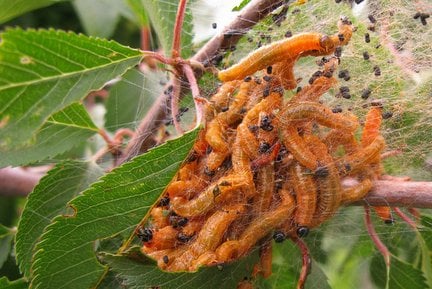
Quick facts
Common name - Social pear sawfly
Scientific name - Neurotoma saltuum
Plants affected - Pear, hawthorn, cherries
Main symptoms - Orange caterpillar-like larvae and webbing
Most active - June to July
What is social pear sawfly?
Sawflies are in the same group of insects as bees, ants and wasps (the Hymenoptera). They have caterpillar-like larvae that feed on plants, the adults are winged insects that can appear fly-like. More than 500 species of occur in Britain, you can find out more about these insects from British and Irish Sawflies.
Social pear sawfly has orange caterpillar-like larvae that reach 25 mm (1 in) in length. The larvae feed on leaves in groups within webbing which can cover entire branches. Most often seen on pear, it will also feed on hawthorn, cherry, medlar, plum and cotoneaster. Hawthorn and cotoneaster can also be affected by caterpillars of the hawthorn webber and porphyry knothorn moth, these have small brown caterpillars and also produce webbing.
The adult is a 14 mm (½ in) long black winged insect.

Symptoms
Webbing on leaves and branches of pear and some other plants. This webbing contains pale orange caterpillar-like larvae. Leaves within the webbing are consumed.
Management
Social pear is rarely abundant and the presence of this insect can be treated as part of the a healthy garden supports as it doesn't impact the health of host trees.
- Where possible tolerate populations of sawfly
- Encourage predators and other natural enemies of sawfly in the garden, such as birds, wasps and ground beetles
- If necessary it is possible to control social pear sawfly by pruning out the affected part of the tree and disposing of the larvae
Biology
There is one generation of social pear per year. Eggs are laid on foliage in May and June. The orange caterpillar-like larvae are found during June and early July. They feed in groups within webbing and reach 25 mm long when fully grown. When the larvae have completed their feeding they go down into the soil where they pupate and emerge as adults the following spring.













